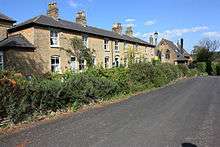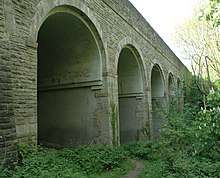Crambeck
Crambeck near Crambe and Malton in Yorkshire is near the River Derwent.
| Crambeck | |
|---|---|
 Crambeck village sign | |
 Crambeck Location within North Yorkshire | |
| OS grid reference | SE73686733 |
| District | |
| Shire county | |
| Region | |
| Country | England |
| Sovereign state | United Kingdom |
| Post town | York |
| Postcode district | YO60 |
| Police | North Yorkshire |
| Fire | North Yorkshire |
| Ambulance | Yorkshire |
| UK Parliament | |
History
Roman
Crambeck is famous in antiquity as having been the Roman ceramic kiln site that lends its name to the locally produced Crambeck Ware pottery.[1] Excavations in Crambeck were undertaken by Philip Corder in 1926–1927 with boys from Bootham School.[2]
Georgian
The nearby Crambeck Road Bridge on the A64 was built in 1785 by John Carr (architect). [3]

Crambeck Village

Crambeck Bridge
Victorian
Crambeck was the home of the Castle Howard Reform School (1856-?1963).[3]
Modern
A local history project recorded memories of life in the village in the 1930s and 1940s.[4]
In June 2014 access to Crambeck was limited by a spillage of mashed potato on the nearby A64.[5][6]
See also
References
- Monaghan, G. 1997.Roman Pottery from York (Archaeology of York Series 16/8). York: York Archaeological Trust. pp903-906
- Corder, P. 1928. The Roman Pottery at Crambeck, Castle Howard (Roman Malton and District Report no.1). York: William Sessions
- "Crambeck Village History". Archived from the original on 25 August 2013. Retrieved 4 February 2015.
- "Castle Howard Station - Personal Memories". 2009. Retrieved 4 February 2015.
- "Mashed potato spillage closes busy road after road smash". Mirror. 22 June 2014. Retrieved 4 February 2015.
- "A64 closed after lorry spills load near Malton". North Yorkshire Police. 22 June 2014. Archived from the original on 4 February 2015. Retrieved 4 February 2015.
This article is issued from Wikipedia. The text is licensed under Creative Commons - Attribution - Sharealike. Additional terms may apply for the media files.